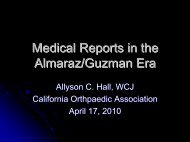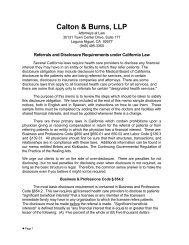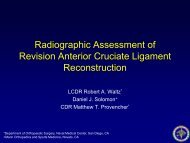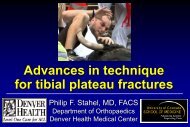Enhancing Your Practice's Revenue - California Orthopaedic ...
Enhancing Your Practice's Revenue - California Orthopaedic ...
Enhancing Your Practice's Revenue - California Orthopaedic ...
- No tags were found...
You also want an ePaper? Increase the reach of your titles
YUMPU automatically turns print PDFs into web optimized ePapers that Google loves.
OperationsRegardless of organization structure, to ensure that theUCC is successful it is critical to secure physician and staffbuy-in. First, you must determine how many and whichdoctors will be providing care at the center. Staffing it atany given time with a hand surgeon or a joint specialist,for example, will not work if the majority of patientsvisiting the center present with trauma or sports injuries.<strong>Your</strong> employees (including administrative and clinicalstaff) need to be trained, organized and prepared to handleboth additional volume and possibly an increased varietyof orthopaedic cases. Plan in advance for the additionaltraining that will be needed.You will also need to decide which (if any) non-physicianextenders or so-called mid-level professionals you wish toutilize; e.g., nurse practitioners, physician assistants, andathletic trainers. See Chapter 1: Non-physician Extenders.Some centers rely primarily on these individuals (regulationspermitting) and medical doctors are contacted if theneed arises. In other UCCs, a licensed physician is alwayspresent.Contrary to a conventional orthopaedic office where thescope of elective patients is relatively controlled, the UCCphysicians and personnel need to be able to provide carefor a wide range of orthopaedic problems, from a shoulderdislocation to a pediatric supra condylar elbow fracture.Note that other staffing options include a part-timenon-operative orthopaedic surgeon, family practitioner,an internist with sports medicine experience (or even anorthopaedic resident looking to moonlight!). See Chapter2: Non-surgical Physicians.Projecting UCC ProfitabilityConduct a survey to determine how many net new patientsthe center would likely generate. A simple phone surveyasking local referring physicians or a mail-in survey to acohort of practice patients should yield insight regardinghow well the UCC will be received. Then, develop apro forma (or three – see below) for your practice on aconsolidated basis and compare it to your current situation.Bear two things in mind as you do this. First, all patientsseen in the UCC are not “gravy;” some are patients whowould have been gone to your office and you cannot countthem twice. Also, if you as an orthopaedic surgeon staff theUCC during a time when you would have otherwise performedsurgery and you do not make up this income at anothertime, that too is foregone income.1. Calculate the revenues from your practice and UCCcombined, reflecting potentially higher levels of UCCreimbursement. Deduct money you will not receivefrom UCC patients who would otherwise have gone tothe office (but don’t forget to use office reimbursementrates). Also deduct income from surgeries you will notbe performing (if any) because you cannot be in theOR and see patients at the UCC at the same time.2. Calculate the cost of your office and UCC combined.Consider:- <strong>Your</strong> occupancy costs will not increase if you openyour UCC in your current office but will rise if youoccupy another site. Utilities will increase in bothscenarios.- If you open your center in a new location, you willneed to purchase or lease furniture, fixtures andequipment. New equipment, including x-ray, will beexpensive.- Check with your insurance broker as far as property,casualty and other insurance is concerned; costs willcertainly increase with a new facility; they may not ifyou remain in one place.- Make an estimate of your total medical and surgicalexpenses; these will without doubt increase regardlessof whether you use existing space or set up a new PC.- Think about other outlays you will need to make,including those for marketing, legal, accounting,information systems, and billing/collection, which aresure to increase.- Finally, calculate your total personnel costs, including(a) increased overtime for existing staff and (b) anynew staff that you feel you need to hire. Rememberto consider benefits.Subtract projected expenses (2) from projected revenues(1) to determine net profit for the practice and the UCCcombined. Compare this net profit to the projected profitabilityfor your practice without the UCC for the sameperiod of time. <strong>Your</strong> financial statements for the most recentyear should serve as a basis for this. See # 1 in Ten TopTips, in the Appendix.Ideally, develop at least three pro formas for your combinedoperation: a best case, an expected case, and a worstcase scenario. (Ask a business advisor for assistance withthis if necessary.) If the worst case scenario still results in aprofit that is acceptable to you, then developing a UCC issomething you should definitely consider doing. The precedingmay seem like a lot of work, but it is part of the duediligence that you need to undertake before you invest anymoney. Here are some statistics to consider as you considerdeveloping a UCC:• If the current overhead in your office is $350,000 peryear and the average doctor in your office sees 4,500patients per year, then the break-even cost (excludingcompensation to the physicians) to see a patient is almost$78 per patient/year. You should calculate what the costis for you in your particular office on at least an annualbasis.© 2011 American Academy of <strong>Orthopaedic</strong> Surgeons17
















